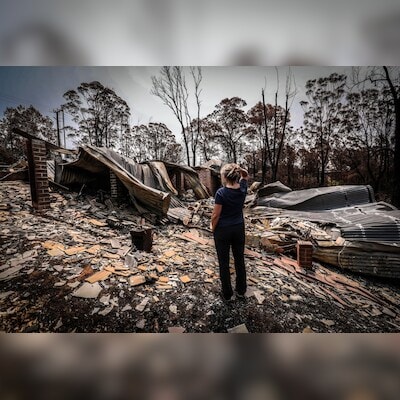Helicopters dropped water on growing wildfires in Northern California on Wednesday as firefighters lined roads to keep flames from reaching homes as the state is hit by extreme heat and at least 26,000 people are forced to evacuate.
The Thompson Fire began just before noon Tuesday near Oroville, Butte County, about 70 miles (110 kilometers) north of Sacramento, sending up a huge plume of smoke that was visible from space and spread over more than 5.5 square miles (14 square kilometers). It was impossible to contain.
Click here to connect with us on WhatsApp
But Oroville Mayor David Pittman said the fire had weakened significantly by Wednesday afternoon and he hoped some residents would be able to return home soon. The fire’s progress had stopped on the southern end, and firefighters working in steep terrain were working to establish a containment line on the northern side.
“We’re really struggling with the terrain up north,” Pittman said.
Meanwhile, another fire broke out about five miles (8 kilometers) south of Oroville on Wednesday afternoon, prompting new evacuations near the town of Palermo. That blaze, named the Grubbs Fire, also has not been contained.
More than 10 fires, most of them small, were burning across the state, according to Cal Fire. One fire that broke out Wednesday afternoon prompted temporary evacuations in Simi Valley, a densely populated city about 40 miles (65 kilometers) northwest of downtown Los Angeles.
The state’s largest blaze, the Basin Fire, has burned about 22 square miles (57 square kilometers) of Sierra National Forest in eastern Fresno County and is 26 percent contained.
A state of emergency was declared and evacuations were opened in Oroville on Tuesday night. The evacuation zone was expanded Wednesday to include hilly and rural areas outside the city of Oroville, population about 20,000. With the Fourth of July in mind, officials warned that fireworks would be banned in many places, including most of Butte County.
There were no immediate official reports of property damage. An Associated Press photographer saw flames engulf three adjacent suburban homes in Oroville.
The fire started on a sprig of grass protruding from the concrete edge of Lake Oroville, and gusty winds fanned the American flags that lined the bend of the dam, the state’s second-largest reservoir and the nation’s tallest.
Residents stood on hillsides at night watching the orange lights as planes dropped water to stop the flames from spreading. More than a dozen firefighters managed to save one home as goats and other livestock fled for safety.
The cause of the fire is under investigation. At the time the fire started, a red flag warning was issued, indicating weather conditions that can be dangerous for fires, such as gusty winds and low humidity.
“The conditions in our county this summer are much different than the past two summers. The fuels are very thick, the brush is very dry, and as you can see, when the wind picks up, the fire gets put out very quickly,” said Garrett Shorland, Cal Fire’s Butte County division chief.
In response, Pacific Gas & Electric Co. implemented public safety power shutoffs in parts of several Northern California counties to prevent fires from downed or damaged power lines.
Hot conditions, with temperatures likely to reach triple digits, are expected to continue into next week.
Authorities have warned that anyone who uses illegal fireworks on Independence Day on July 4th will face full legal action.
“Don’t be stupid and start a fire and cause us more problems,” Butte County Sheriff Corey L. Honea said. “Nobody in the community wants that, and we definitely don’t want this.”
The governor’s office announced late Tuesday that federal funding has been approved to help with firefighting efforts. Gov. Gavin Newsom launched a state operations center this week to coordinate California’s response, dispatch mutual aid and help communities respond to wildfire and heat threats.
In Southern California, Joshua Tree National Park officials on Wednesday closed Covington Flats, home to most of the park’s important Joshua trees, because of the high fire danger caused by grass that had grown lushly after spring rains but has now died. A June 2023 fire destroyed 1.6 square miles (4.14 square kilometers) of Joshua trees and desert tortoise habitat.



